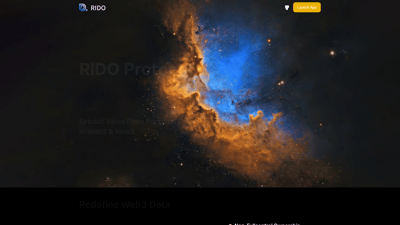RIDO Protocol is revolutionizing the way we interact with personal data in both Web2 and Web3 environments. By enabling users to extract value from their data, RIDO empowers individuals with ownership and control over their information. With features like programmable data generation and access control, RIDO facilitates seamless data sharing and monetization, creating a rich ecosystem for users and applications alike. Discover how RIDO is redefining data ownership and value extraction in the digital age.
Rido
Features of RIDO Protocol
1. Non-Fullcontrol Ownership
RIDO Protocol allows data owners to manage access permissions while ensuring that any modifications adhere to predefined rules. This feature guarantees that users maintain control over their data while still allowing for necessary adjustments.
2. Programmable Data Generation
Users can define new data variables, specifying their structure and generation functions. This flexibility allows for the creation of customized data that can be utilized across various applications, enhancing interoperability.
3. Programmable Access Control
Data owners can set specific access control rules using NFTs, tokens, or custom logic. This feature ensures that only authorized individuals can access sensitive data, enhancing security and privacy.
4. Migrate Web2 Data
RIDO facilitates the transition of traditional Web2 data to a Web3 environment through the BNB Attestation Service. This migration clarifies data ownership and provides users with diverse access control methods, enabling effective data monetization.
5. Cross-application Data Sharing
RIDO promotes low-friction data sharing between applications, leading to a more composable and enriched application ecosystem. Users can control their data while benefiting from its integration across platforms.
6. Data Marketplace & DataFi
RIDO constructs a two-way data marketplace where users can list or offer their data. The DataFi protocol enhances the flow of data information and value, allowing users to monetize their data effectively.
7. AI Support
RIDO features a decentralized recommendation system that leverages user data to create personalized experiences. Additionally, it offers a digital assistant for conversational interactions based on user preferences, enhancing user engagement.
8. Virtual Life
Users can create immersive 3D environments to interact with digital objects and other users, enriching their online experiences and fostering community engagement.
RIDO Protocol FAQs
What is RIDO Protocol?
RIDO Protocol is a platform that enables users to extract value from their personal data in both Web2 and Web3 environments, offering features for data ownership and programmable access control.
How does RIDO ensure data ownership?
RIDO allows users to define access permissions and manage their data through programmable rules, ensuring that they retain ownership and control over their information.
Can I migrate my Web2 data to RIDO?
Yes, RIDO facilitates the migration of traditional Web2 data to a Web3 environment, clarifying ownership and providing various access control options.
What is the DataFi protocol?
The DataFi protocol within RIDO promotes the flow of data information and value, allowing users to monetize their data effectively through a two-way marketplace.
How does the AI support work?
RIDO features a decentralized recommendation system that utilizes user data to provide personalized experiences, along with a digital assistant for enhanced user interaction.
